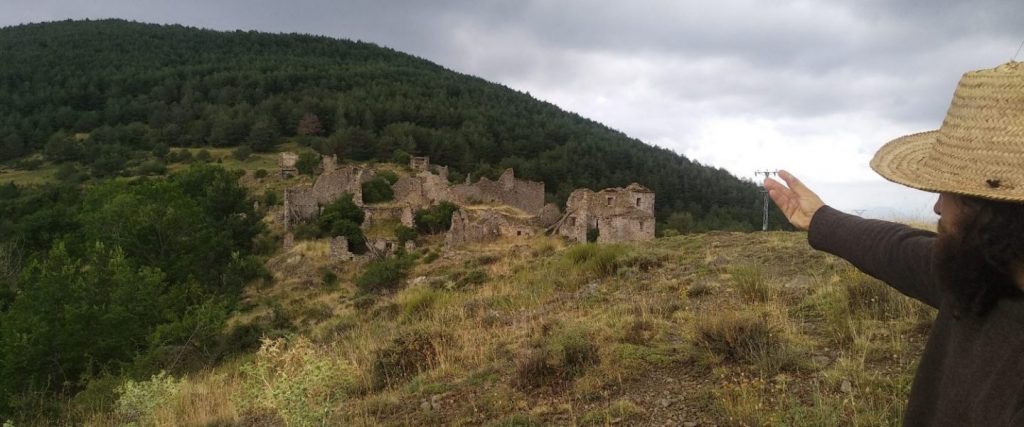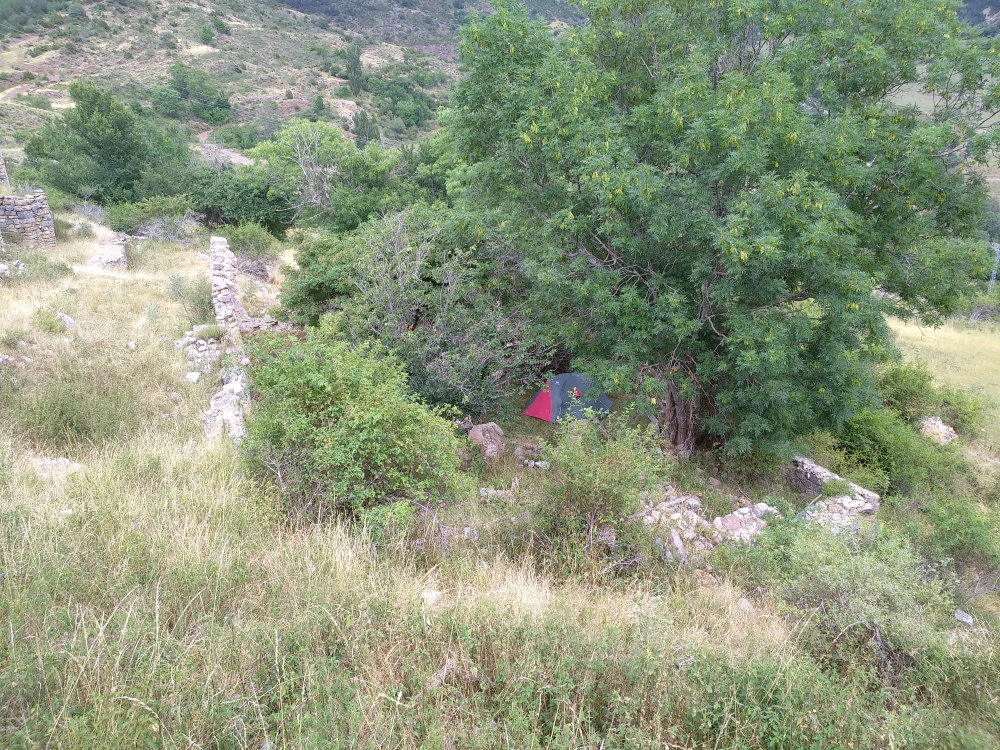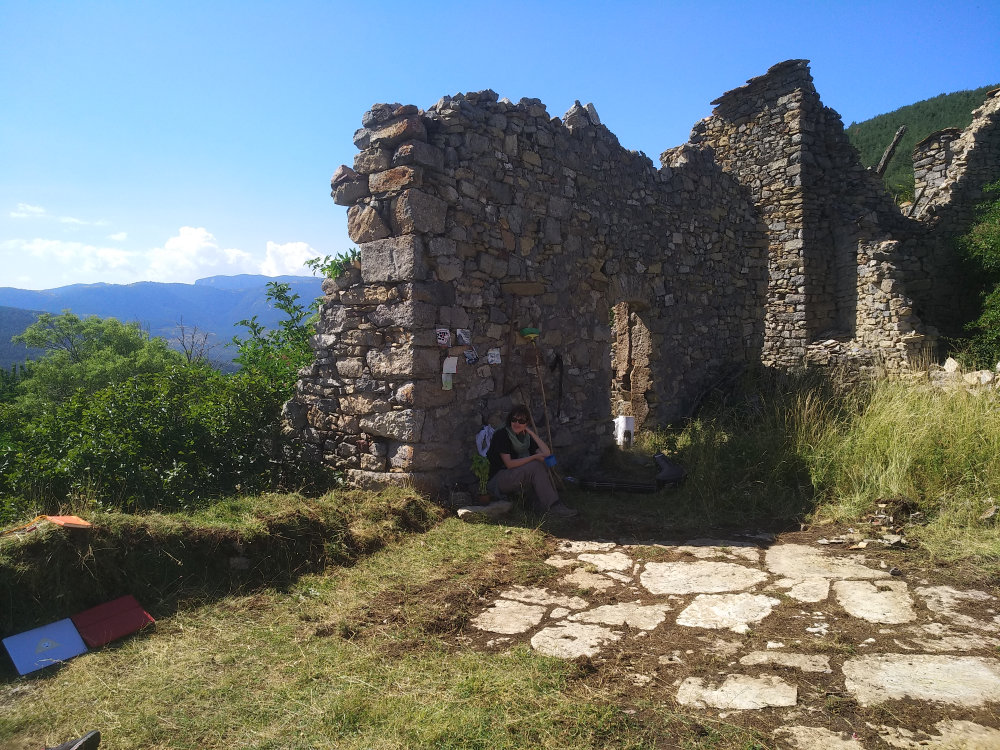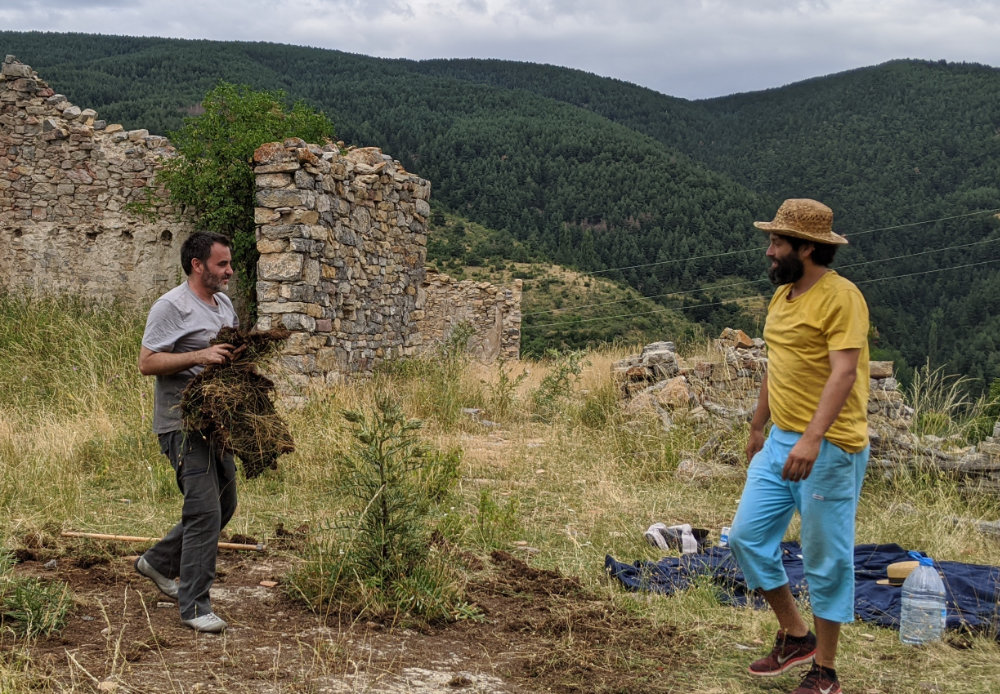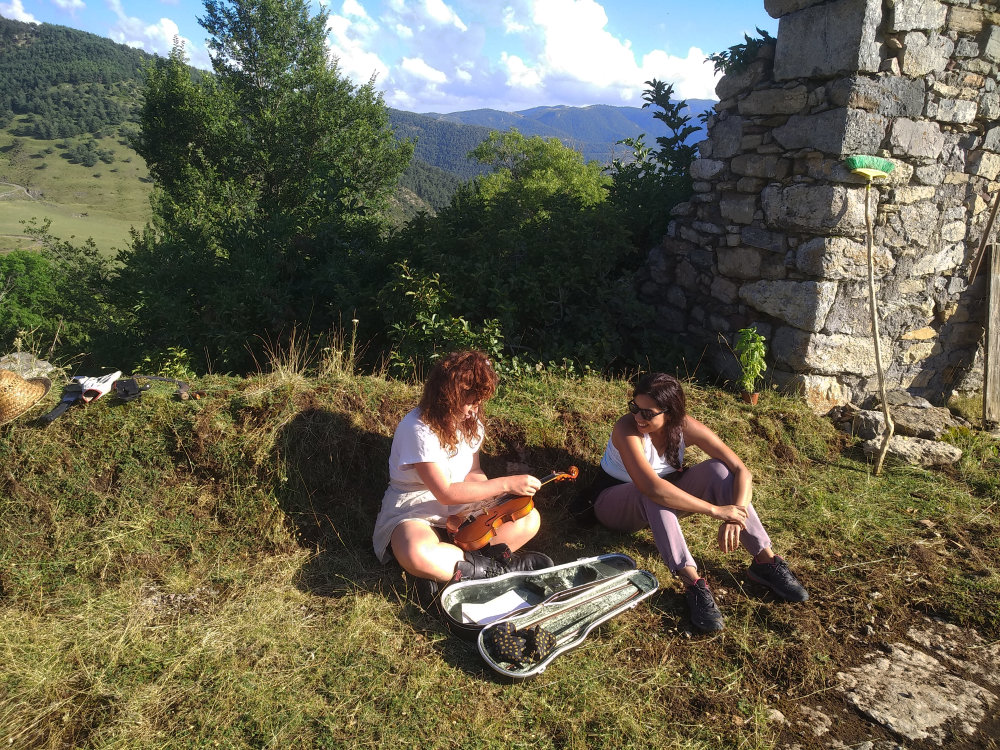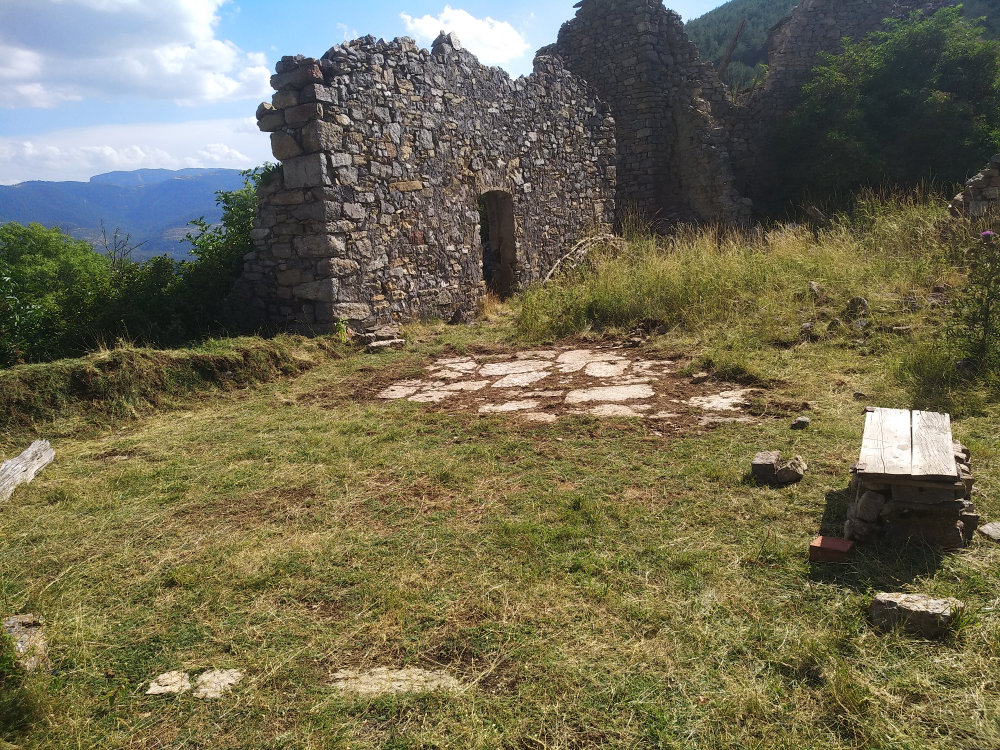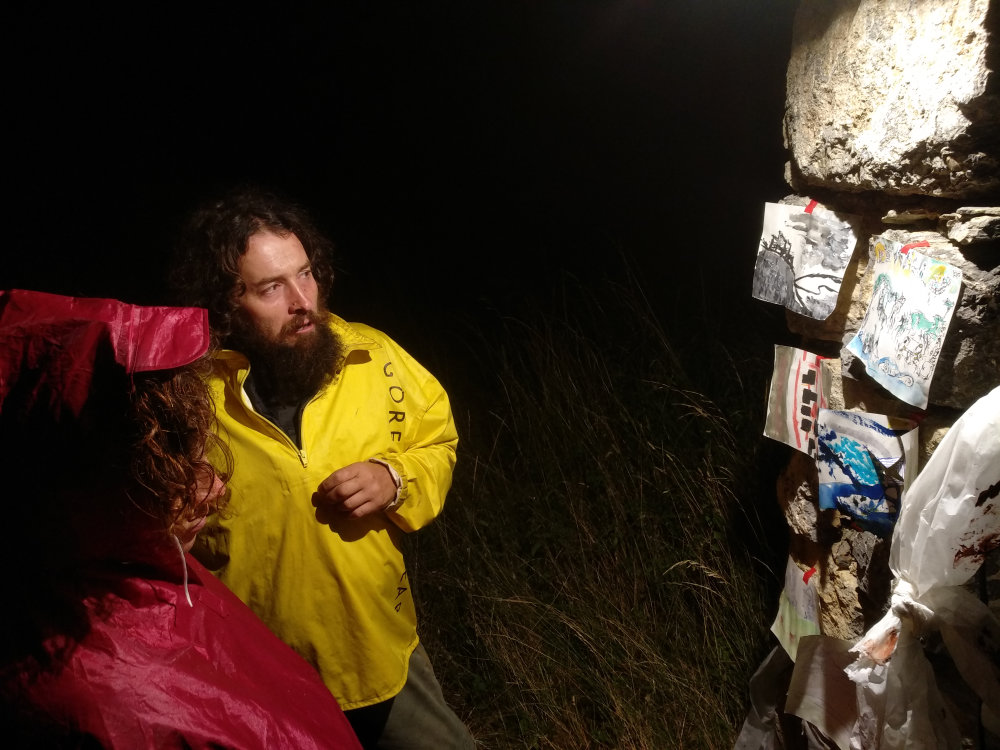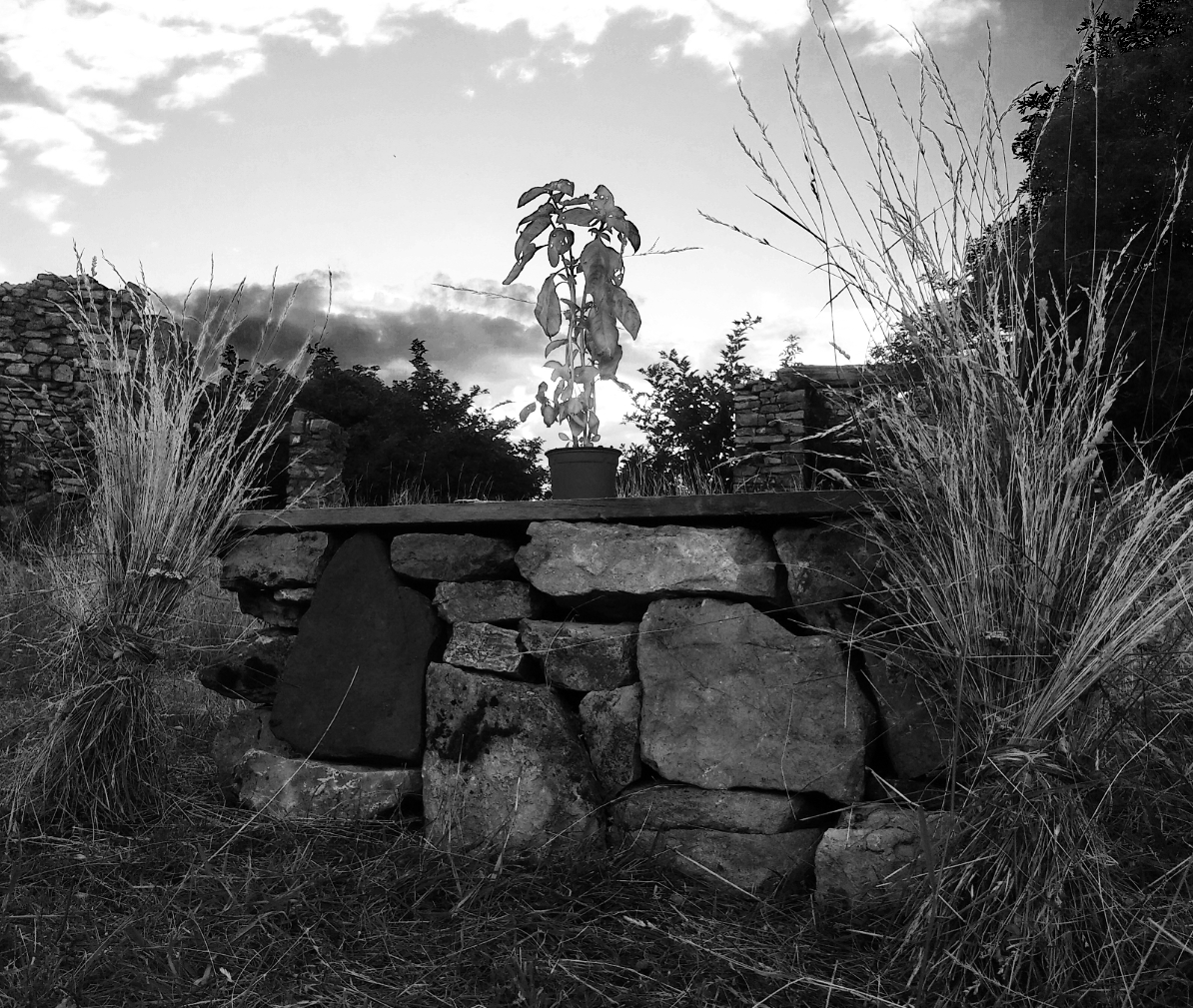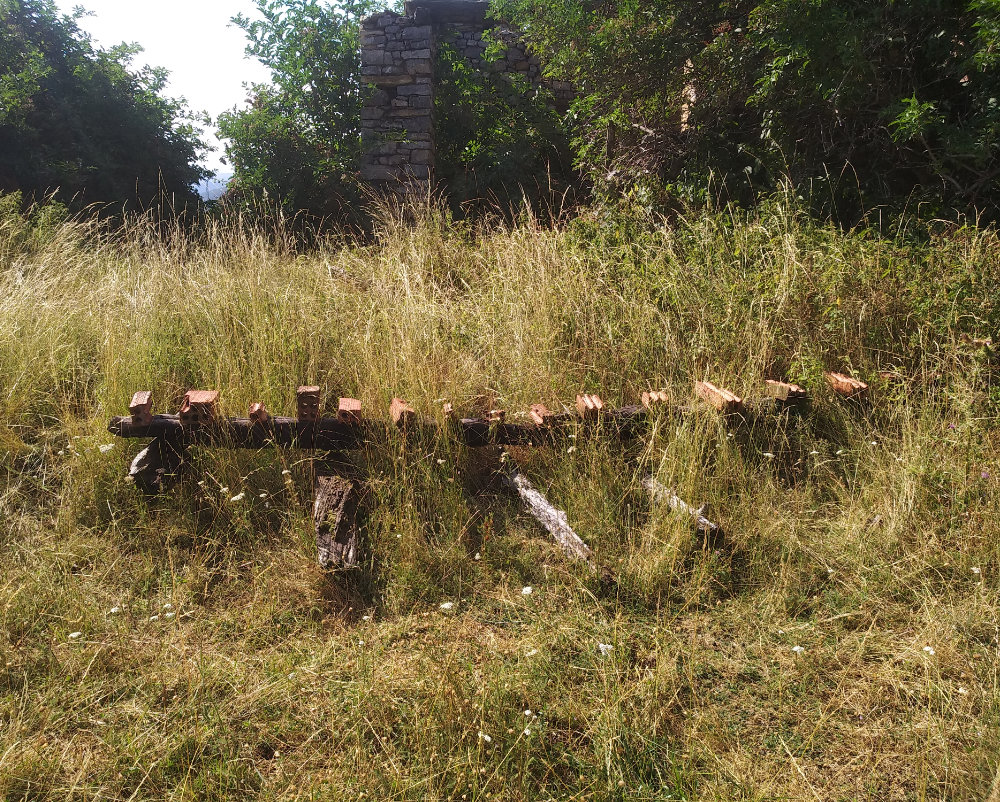Especulograma de Sant Sebastià
 Live art / environmental performance / social practice | Especulograma de Sant Sebastià , August , 2020
Live art / environmental performance / social practice | Especulograma de Sant Sebastià , August , 2020
When I first arrived in Catalonia, pau mentioned perhaps we could go survey an abandoned village in the Pyrenees. The conversation developed over days in snatches of conversation. The abandoned village became an imaginary site gathering ideas, propositions, and speculations in our conversations. The interesting problems and possibilities of city dwellers escaping the city and flooding the countryside mixed with our longer conversations about growing cities into forests ~ in both senses, transforming cities into forests and cultivating civic people back into some abandoned lands. The vine collective pau is working with is similarly interested in revitalization of land, plant, and human relations.
How about we go to this abandoned village Sant Sebastià? Let us create an invitation for the urban refugees to join a project regrowing this village along the lines of growing the city into a forest. A few weeks ago, the trip started to come together. At first it seemed it might just be pau and I, but we had the good fortune to be gathered into an extraordinary team of inconvenient realists.
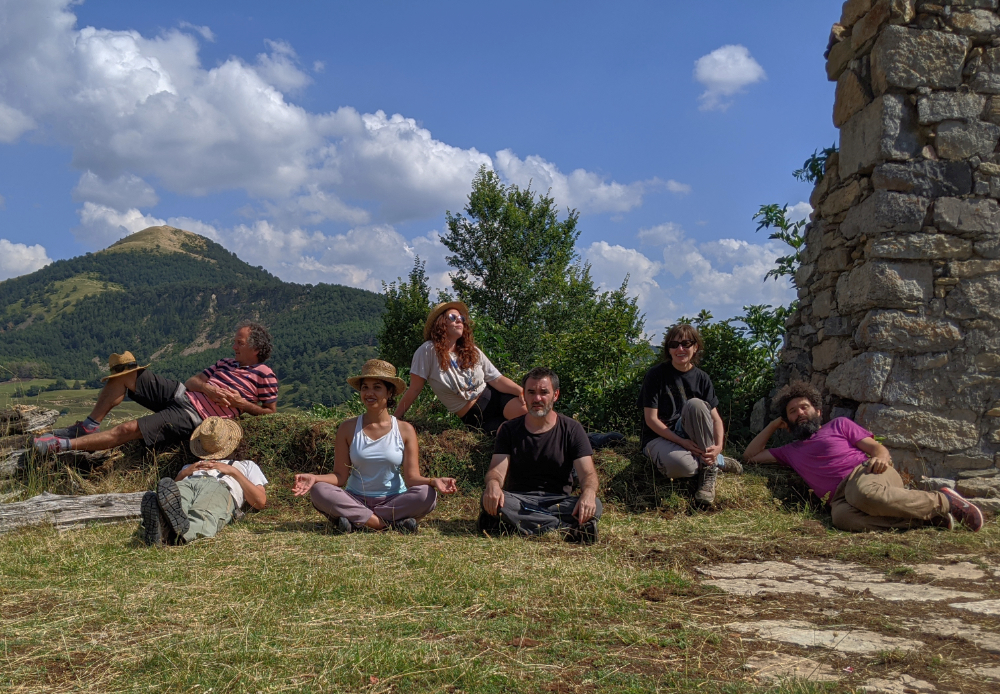 Iso-phytosebastinian collective (left-to-right)
Iso-phytosebastinian collective (left-to-right)
- Ignacio Mas – abdicated economist and educator
- pau – amateur viticulturist, headless thinker, and our navigator
- Babita Singh – scientist and chef
- Melanie Curran – writer and musician
- Juan Pintabona – architect and chef
- Monica Bouso – archeologist and educator
- duskin drum – academic and woodsman
Arrival
Initially, from our conversations, I had the impression that the village was intact. Upon arrival, I found the village is an abandoned ruin. Most of the buildings’ roofs have long caved in and their walls poured their stones into the former living spaces of residents mysteriously vanished. We speculated … why was this place abandoned? Juan asserted perhaps the better question; “Why haven’t they come back again?” Perhaps, the last resident expected to come back in just a few days, and only returned finally when she was buried behind the church.
Arriving late in the afternoon, we went about setting up a kitchen and pitching tents. We did a little exploring – enjoying the last light of the long summer’s day. The village is perched on a saddle with a one terraced meadow vale descending with hedge rows of abandoned fruit and nut root stock to the southeast, and another steeper wooded valley plunging down to the west. Above the village to the southwest a middle-aged pine forest overgrows abandoned agricultural terraces. To the north we can see the steep ridges of the Pyrenees. Sheep and cows wander the hills in the thousands, often in the distance we hear their symphonies of bells.
pau immediately set out looking for the water source, a spring he remembered from previous trip. pau had been here many years before and retained an urge to investigate this place and its circumstances. He even has a distant relative who still has title to a house. Before leaving for Sant Sebastià, pau poked around the civic registrations discovering an irregularity – the village had been removed from the tax roles in the municipal registration. This seems to contradict people still owning houses. Thus, pau suggested when we arrive, perhaps each of us settle in one of the abandoned houses. That way we would not be subject to the whims and prejudices of the landlord or tenet of the grazing lands but rather to the individual owners of houses. When the forest service police came – they didn’t give a damn for that argument.
Kitchen
The kitchen clung like a barnacle in the lee of the corner of the last standing building. The kitchen never really made it out of the parking lot and into the village. It was like a beachhead or an outpost staying close to the cars with their promise of retreats of petro-ease.
We cooked on a couple of gas burners improvising old planks for cutting boards. Our food was quite good. It included a mix of Iberian, Chinese, American, and Indian. We enjoyed global cuisine in the ruins of an abandoned Iberian village. This is a touch of this sort of post-urban, after the city has manifest, rural cosmopolitanism, I am sensitive to lately – civilization / cities going to seed and dehiscing its planetary and global gatherings in form of seeds that are all also human shaped people. Everything else pouring out of the cities, from carbon dioxide to terminator seeds to urban raccoons, is also our siblings and cousins. Is there even any place “outside” of the pervasive planetary material impacts and emotional claims of the “city” and it’s dwellers? Where does the sprawl end? The moon? Mars?
Sweet waters ~
The spring turned out to be lower than we hoped; it is a bit of a climb back up to the village with big jugs. But the water is quite sweet. I woke up early on the first morning and found the spring following pau’s description from the night before. I worked on clearing it out and shaping cascading pools for filling bottles. Remind me of a fantasy of becoming a wandering “spring cleaner” – a sort of itinerant attendant to sacred waters of fresh water springs.
The others joined to make the spring usable. I imagine if, when, Sant Sebastià is resettled, the spring would be built up to have bigger more effective reservoir. A solar powered pump would patiently lift the water up to the village’s cisterns during the day. Probably, these cisterns would also be augmented with rainwater catchment and redeveloping the other spring on the other slope. The water from the spring is quite a bit. I estimate maybe 6 cubic centimeters a second …. this is just a rough calculation … approximately 518,400 cubic cm a day, a little more than 500 liters a day. Not a lot of water, but maybe enough for a small settlement – at least for drinking and cooking.
We later learned from a local, the village had gotten its water by an electric pump or even a mechanical lift. pau had imagined donkeys carrying amphora filled at the nearby stream cascading at the bottom of the southeastern facing vale. In fact, well, really in story, we learned the water was lifted from another spring we later found seeping out of a field below the village. The water used to be gathered in a cement cistern below the spring where containers were filled go be lifted up to the tanks and containers in the village.
Choosing houses proved slightly difficult since most were quite ruined. The former rooms filled in with rubble of stone walls and roofs overgrown in stinging nettles and vicious thistles. The first night we camped in the gentle meadows outside the village. This may have proved our downfall. An early cyclist seeing our tents, parked cars, and simple kitchen stopped. Without a word of hello or how are you, he launched into a monologue about how it is forbidden to camp here, he promised he would not say anything, but, he guessed the next person probably would. Then he rode off – big brother by-product in spandex – attempting to control other people who were doing no harm.
On the second day, Melanie and I moved into one of the building outlines probably an old barn attached to a house or an outbuilding. The ground was green, flat and soft overshadowed by an ash, an oak and rose bushes. The soft soil and green carpet suggested a long ago history of dung. I imagined the trees and bushes as the beginning of a house grown in trees mixed with remnant stones and augmented with tents, tarps, and domes. I hoped to plant willow cuttings all along the walls.
According to our experts, the current stone work of the village was quite recent perhaps even only built and abandoned in the 20th century. Monica, the archeologist, pointed out it is quite likely some version of the chapel predated the village and other sacred situations predated the Christian chapel. The Catalon wiki page hints at a longer history. The village is perched on a saddle back ridge overlooking two valleys giving it a kind of natural geographical relevance especially as there is spring water. I am not a geologist or hydrologist but I suspect the spring used to be a higher elevation – to me it looks like it has slowly drifted down slope perhaps as the slope has eroded.
An Agora
After cobbling together our kitchen, our next space we defined was our living room or agora as we called it fondly referencing the public markets and assembly spaces of ancient Greek cities. We choose a broad open courtyard next to the church and a few other crumbling buildings including a lovely doorway leading the to open air. The courtyard is open, mostly clear with an excellent central location, and a comfortable prospect looking east, southeast and south southeast. Over the days we cleared the thistles and nettles and the loose stones from fallen walls, and tiles from fallen roofs.
Curiosity about the flagstones led us to pull up the layer of moss and grass root mass growing on top of the broad irregular flag stones. Revealing broad irregular flagstones underneath. Is this artificial? We asked, pulling up the thin layer of grass and moss growing on a flagstone courtyard. We later learned it was a family’s threshing floor – appropriate from perspectives upon the pre-history of Greek theatre. Our “agora,” a performance of speculative revitalization, found its stage upon the threshing floor like harvest rites and celebrations, the precursors of Greek drama.
By the middle of the second day, there was an awkward fold and pile of discarded top soil moss layer – turf from the uncovering of the floor. In an flash of inspiration, I realized the turf could be combined with the crumbling wall with the nice view. Picking up the loose stones in the “agora” and reshaping the base of a collapsed wall into a combination bench, table, counter, and couch. We recovered the wall with the turf ripped off the flagstones. The wall became a piece of excellent indoor/outdoor furniture in the imagined “city grown into forest” or “phloemphloem” as we are beginning to call it. “Phloem” is the word describing vascular tissues in plants that transport the produce of the sun down to the roots.
Besides shifting the gray stone wall to green and yellow. I have had further dreams for the agora – first I wanted to raise a mast on the corner sticking out toward the view and hang tarps or sails for sun and rain shelter. Then in the spirit of phloemphloem, imagine an arbor of grapes and kiwis providing shade in the summer. The frames could be steel with grooves designed for grape and kiwi wood to grow- at the end of the fall, the vines could be pruned back to their grooves in the steel ( or carbon fiber) structure revealing openings that seat plexiglass or other transparent materials to make the agora into a covered greenhouse like structure in the cold cold winters in the mountains.
mapping place / toward performing language
On our third day, Melanie suggested we needed a bench, table, or stage like thing in the agora for some exercises she developed for us to do together. She invited all of us to draw or sculpt maps or other schema visualizing San Sebasitià. Then we each shared our drawings or sculptures and explained our depictions. The bench/table served as our shared working surface, dinner table, and would have been the stage for the next nights performances if we were not evicted by the forest police.
Visitors
Besides the unfriendly mountain biker, baptized “bbbp, big brother by-product” we came to suspect reported us to the forest police, we had a handful of other visitors. The first was Roberto a slim and rangy – chatty fellow. He is the shepherd. He works long days tending for 3000 sheep. He was pleased to have neighbors. I was quite surprised to learn he is Brazilian.
The next day I was alone when visited by a small convoy of vehicles – I attempted communications in my broken cata-spanglish . I explained we were studying how Sant Sebastià was lived and how it might be lived again. They told me they were from another village on the other side of the ridge to the north. They told me how hard and cold the winters are – three months frozen. the Pyrenees are quite high. All and all they seemed friendly and sympathetic to our investigation.
—Saint Sebastien Basilicum de Sant Sebastiá
The abandoned village is named Sant Sebasitià after the martyred Roman Christian from the third century. He is renowned for surviving multiple arrow wounds. He was nursed back to health and later properly martyred – beat to death. This saint – whose arrow wounds resembled the buboes of black death came to be sought out for prevention of pestilence – a saint for these corona times. Further, the arrows were associated with Apollo shooting plague arrows. Saint Sebastian became one of the frequently painted Christian subjects in European art. It seems like everyone does one. Egon Schiele even does a self portrait as St Sebastian. Damien Hirst’s Sebastian is a sculpture including a cow carcass. My favorite St Sebastian might be Fiona Tan’s video.
There was a basil plant we had bought in the market in Olot – when getting supplies. At some point, sitting on the second morning looking at grass. pau noted they look like arrows.
The basil plant looked like common compositions of Sebastian. Inspiration struck, an epiphany that Saint Sebastian is a plant, can be vegetal saint. Saint Sebastian manifested to us a basil plant. A living sculpture was made.
A Descendant Visits and the Eviction
Our final day was busy with visitors culminating with the forest police suggesting we leave. Before the police arrived, some old folks came by with their two grandchildren. The woman named Teresa turned out to be the daughter of a woman who grew up and lived in the house next to the agora. In fact she explained, our agora was the threshing courtyard of her family – the enclosed courtyard of the their house complex. She told us strange, interesting and terrifying stories including a tale of a mummy buried before the doorway with it’s head pounded full of nail. Meanwhile, other members of our group toured around with her husband who explained the histories of people buried in the small church and gave a speculative account of the blow by blow fighting here in the end of the Spanish Civil war. They explained how people moved away because the life was hard and easier in nearby lower towns. They seemed excited at speculating about a revival of the village. It seemed both old folks were just warming up to their stories when the striped green truck of the forest police arrived.
A long drawn out debate / conversation with the forest police ensued. I missed most of it. Turned out the rub was – someone had complained about us – we were ratted out. We suspected the biker dude but maybe it was the convoy – we somehow cannot really know. The fallout was – we could stay if we took down the tents and didn’t cook with our gas stoves. We decided to leave.
Unfinished
I was sad to be leaving early. I had wanted to get one more little intervention done. I had found a big willow tree and I want to harvest cuttings to plant along the wall where we pitched our tent. I wanted to show a speculative beginning for replanting and regrowing the wall with willow.
For me the entire visit / investigation /intervention was framed and metabolizing the questions, “can we grow the city into a forest?” and the corollary, “does this village offer a viable testing ground of growing a model?” I labored furiously and energetically on our interventions. Sadly, hurting my back in the process; ah, the charms of middle-age.
Though we left early with hardly anything started and barely the beginning of our conversations, I felt energized in pursuing these question and dedicating focused energy toward this project. Hopefully, we are forming a team or fledgling group that might grow into a serious funded lab. I am developing versions of the plans for applications going forward this fall.
Our especulograma should appear at https://santsebastia.org soon.

